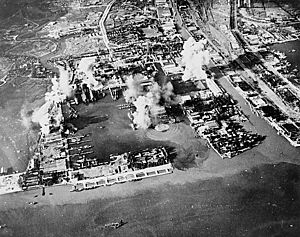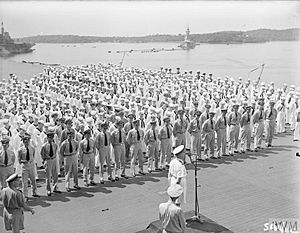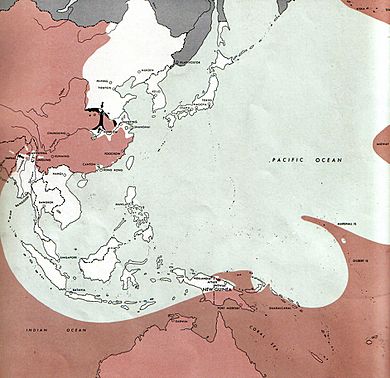Operation Transom facts for kids
Quick facts for kids Operation Transom |
|||||||
|---|---|---|---|---|---|---|---|
| Part of the South-East Asian theatre of World War II | |||||||
 Surabaya during the attack by Allied carrier aircraft on 17 May 1944 |
|||||||
|
|||||||
| Belligerents | |||||||
| Commanders and leaders | |||||||
| Strength | |||||||
| 76 aircraft 2 aircraft carriers 3 battleships 1 battlecruiser 6 cruisers 14 destroyers 8 submarines |
Anti-aircraft batteries | ||||||
| Casualties and losses | |||||||
| 3 aircraft destroyed | Accounts differ | ||||||
| Unknown civilian casualties | |||||||
Operation Transom was a big attack by Allied forces during World War II. It happened on May 17, 1944. The target was the city of Surabaya on the island of Java, which was controlled by Japan.
The attack was led by the British Eastern Fleet. It involved both American and British carrier-based aircraft. These planes bombed the city's docks and an oil refinery. Sadly, one American plane was shot down, and two British planes were lost in accidents.
This attack was the second and last time American and British aircraft carriers worked together in the Indian Ocean in 1944. Its main goal was to make Japan move its forces away from New Guinea. This would help the Allies with their landing on Wakde island. The American aircraft carrier was also on its way back to the Pacific, so they decided to use it for this mission.
The warships for Operation Transom sailed from Ceylon (now Sri Lanka). They refueled in Western Australia before heading towards Java. From there, the aircraft launched their attack. On the morning of May 17, two groups of Allied planes attacked Surabaya by surprise.
Later that night, American heavy bombers also hit Surabaya. Australian planes then dropped mines in the nearby waters. These planes flew from bases in northern Australia.
People have different ideas about how much damage the Allies caused. Some say it wasn't much, while others believe it was a lot. We don't know how many civilians were hurt. However, everyone agrees that the British Royal Navy learned a lot from the United States Navy's better carrier tactics. The attack didn't make Japan change its military plans because they didn't see the Eastern Fleet as a big threat.
Contents
Why the Attack Happened
Surabaya During World War II
Surabaya is a city in eastern Java, which was part of the Netherlands East Indies (NEI) during World War II. In the late 1800s, it became one of Asia's main port cities. It was also a big center for exporting sugar.
Even though Surabaya's economy slowed down in the 1920s, it stayed an important trading city. Japanese forces invaded and took over most of the NEI between December 1941 and March 1942. Surabaya was bombed many times during this time. The first air raid hit the city's port and naval base. The Dutch army there gave up on March 8. Like the rest of Java, Surabaya was controlled by the Imperial Japanese Army during the war.
Surabaya remained an important naval base and industrial hub for Japan. Japanese forces there hunted Allied submarines in the Java Sea. The Wonokromo oil refinery in the city was the only place in Java that made aviation fuel (fuel for planes).
Allied planes attacked Surabaya many times. Big raids happened on July 22 and the night of November 8/9, 1943. Smaller raids happened almost every month from February 1944 until the war ended in August 1945. Australian planes also regularly dropped naval mines near Surabaya's port entrance starting in August 1943. These mines caused a lot of trouble for Japanese ships.
Allied and Japanese War Plans
From mid-1942 to early 1944, the Allies didn't do many attacks in the Indian Ocean. Their main naval force there was the small British-led Eastern Fleet. Admiral Sir James Somerville was its commander. By late 1943, this fleet didn't have any aircraft carriers or many strong battleships. The remaining ships could only protect Allied shipping. Luckily, Japan didn't try any big attacks in the Indian Ocean after mid-1942. This allowed the Eastern Fleet to focus on fighting German and Japanese submarines.

In November 1943, Allied leaders met at the Cairo Conference. They decided that the main fight against Japan would be in the Pacific. The Indian Ocean would be a less important area. Any attacks there would be to keep pressure on the enemy and make them spread out their forces.
In January 1944, the British Admiralty (the British Navy's leaders) decided to send many more ships to the Eastern Fleet. This was possible because the Italian Navy had surrendered in 1943. This meant the British Navy had fewer enemies in the Mediterranean Sea. About 146 warships were planned to arrive over the next four months. These included battleships, aircraft carriers, and many other ships. The first group of these ships arrived at the Eastern Fleet's base in Ceylon on January 27. These included the aircraft carrier HMS Illustrious and battleships HMS Queen Elizabeth and Valiant.
In early 1944, the main Japanese naval force, the Combined Fleet, moved to Singapore. They did this because their bases in the central Pacific were becoming unsafe from American attacks. They also wanted to be near good ship repair places and fuel. Japan didn't plan any big attacks into the Indian Ocean. Admiral Somerville believed his fleet couldn't fight the Combined Fleet if it came into the Indian Ocean. More air units were sent to protect Ceylon. The United States Navy also agreed to temporarily send the aircraft carrier USS Saratoga and three destroyers to help the Eastern Fleet.
Saratoga and its escort ships joined the Eastern Fleet on March 27, 1944. Illustrious and Saratoga, along with many other Eastern Fleet ships, successfully attacked the Japanese-held island of Sabang on April 19. This was part of Operation Cockpit. The Allied planes sank one ship, damaged oil tanks, and destroyed up to 24 Japanese planes on the ground. Only one Allied plane was shot down.
Getting Ready for the Attack
After Operation Cockpit, Saratoga was ordered to return to the United States for repairs. The head of the US Navy, Admiral Ernest King, suggested to Admiral Lord Louis Mountbatten (the commander in South East Asia) that the carrier and other ships attack Surabaya on its way back. King hoped this would make Japan move its forces before the Allied landing at Wakde island on May 17. Mountbatten agreed.
Admiral Somerville decided to use almost the same ships for this attack as for Operation Cockpit. One big change was using Grumman Avenger planes instead of Illustrious's usual Fairey Barracuda planes. This was because Surabaya's defenses were expected to be stronger. Also, Somerville wanted to launch the planes from 180 miles (290 km) away, which was too far for the Barracudas.
Because of the long distance from Ceylon and the Royal Navy's lack of experience refueling at sea, the fleet planned to refuel at Exmouth Gulf in Western Australia. The United States Army Air Forces' 380th Bombardment Group, based near Darwin in Australia, was also going to bomb Surabaya the night after the carrier raid. This was to stop Japan from sending planes to attack the Eastern Fleet as it left. The Allies had good information about Japanese locations in Surabaya, which helped them plan the air raids.
The Eastern Fleet was split into three groups for Operation Transom.
- Force 65 had the battleships Queen Elizabeth, Valiant, Renown, the French battleship Richelieu, two cruisers, and eight destroyers.
- Force 66 had Illustrious, Saratoga, two cruisers, and six destroyers.
- Force 67 was the refueling group. It had six tankers, a water distilling ship, and two cruisers.
Admiral Somerville commanded the fleet from Queen Elizabeth. The warships came from six different navies. Two squadrons of Supermarine Spitfire fighters were moved to Exmouth Gulf to protect the Eastern Fleet while it refueled. Australian and American patrol planes also watched the sea.
Each aircraft carrier had its own group of planes. Illustrious had two squadrons with 14 Vought F4U Corsair fighters each, and two squadrons with nine Avengers. Saratoga's air group had a squadron with 26 Grumman F6F Hellcat fighters, a squadron with 24 Douglas SBD Dauntless dive bombers, and a squadron with 18 Avenger torpedo bombers.
Surabaya's defenses against air attacks were not very strong. They had a few anti-aircraft guns, but the crews weren't well trained. Japan had the Imperial Japanese Army's 28th Independent Mixed Brigade and the Imperial Japanese Navy's 2nd Southern Expeditionary Fleet in the city.
The Attack Begins
Force 67, the refueling group, sailed first on April 30. Forces 65 and 66 sailed on May 6. The Allied ships traveled in a way that kept them far from Japanese airfields. This was to avoid being seen or attacked. The planes on the carriers practiced their attack three times during the trip. The warships arrived at Exmouth Gulf on May 14 and 15. While refueling, Somerville met with other commanders to get the latest information.
The Eastern Fleet left Exmouth Gulf on the afternoon of May 15 and headed north. They reached the launch point at 6:30 am on May 17 without being detected by the Japanese. Eight submarines also took positions near Surabaya and other straits. Their job was to rescue Allied aircrew, attack ships trying to escape, and stop any Japanese warships from attacking the Allied fleet.
The planes launched by the carriers were split into two attack groups.
- Force A had nine Avengers from Illustrious, twelve Dauntless dive bombers, and eight Corsairs for protection. Force A's Avengers were to bomb the Braat Engineering Works, and the Dauntlesses were to hit the oil refinery.
- Force B was to attack ships and docks in Surabaya's port. It had twenty-one Avengers and six Dauntlesses, protected by eight Corsairs and twelve Hellcats.
Commander Joseph C. Clifton, who led Saratoga's air group, was in charge of both carriers' air wings during the attack. All planes were launched and ready by 7:20 am. Two British Avengers crashed during takeoff, but their crews were rescued.
The attack on Surabaya started at 8:30 am. The Japanese didn't see the planes coming and were completely surprised. The two forces attacked together. Force A came from the south to Wonokromo, and Force B attacked the port from the north. There were no Japanese fighter planes, and their anti-aircraft guns didn't do much. One of Saratoga's Avengers was shot down, and its two crew members became prisoners of war.
The Allied pilots thought they had caused a lot of damage. They claimed to have damaged ten ships, destroyed the Wonokromo oil refinery and the Braat Engineering Works, and ruined 16 planes and several buildings at an airfield.
After the planes landed back on the carriers at 10:50 am, the Eastern Fleet moved south-west. This was to hide that they were going back to Exmouth Gulf. Somerville's team didn't ask the lead pilot, Clifton, for a report right away. So, they didn't learn until 3:00 pm that many good targets, including Japanese submarines, were still in Surabaya's port. Somerville later wished he had ordered a second attack that afternoon.
The eight submarines that helped in Operation Transom weren't needed to rescue pilots. None of them sank ships escaping from Surabaya. USS Rasher attacked a Japanese convoy near Ambon on May 11, sinking one ship. USS Angler sank a cargo ship on May 20.
A heavy bomber raid on Surabaya happened on the night of May 17/18. Seven Consolidated B-24 Liberators flew from Darwin. They refueled and then attacked Surabaya's port with bombs. This caused more fires and damage. Australian planes also dropped mines near the city in May to help the landing at Wakde. One Australian plane was destroyed during a mine-laying mission on May 20/21.
What Happened Next
Later Operations
Saratoga and its three American escort destroyers left the Eastern Fleet just before sunset on May 18. They headed to Fremantle. The rest of the Eastern Fleet reached Exmouth Gulf the next morning. They refueled and then sailed for Ceylon before sunset. The Eastern Fleet arrived back in Ceylon on May 27. Saratoga reached Bremerton, Washington, on June 10. After repairs, it rejoined the Pacific Fleet in September 1944.
Operation Transom, like other carrier raids by the Eastern Fleet in 1944, didn't make Japan change its military plans. This was because the Japanese Combined Fleet didn't see the Eastern Fleet as a big threat. Japan was saving its strength for a major American attack expected in the central Pacific. The Japanese leaders wrongly thought the American landing at Biak on May 27 was the main Allied effort. So, the Combined Fleet sent a strong force to counter-attack on June 10. This attack was canceled two days later when it became clear that the Americans were about to invade the Mariana Islands. The Combined Fleet was then defeated during the Battle of the Philippine Sea on June 19-20.
How Successful Was It?
People have different ideas about how much damage Operation Transom caused. Stephen Roskill, a historian for the Royal Navy, wrote in 1960 that the Allies thought they had sunk or damaged many ships and caused a lot of destruction. However, Japanese records didn't show that their ships or shore facilities were badly hit. These records said only one small ship was sunk. Roskill believed that the fires started on shore made the Allied pilots think they had done more damage than they actually did. Other historians agree with this view.
However, other historians believe the attack was a success for the Allies. Stanley Woodburn Kirby, a historian for the British effort in South East Asia, wrote in 1962 that the Wonokromo oil refinery and other factories were set on fire. He also said the naval dockyard was bombed and twelve Japanese planes were destroyed on the ground. H.P. Willmott noted in 1996 that the raid caused "severe damage" to the Wonokromo oil refinery and the dockyard. He also said a minesweeper, a submarine chaser, and a naval freighter were sunk.
Jürgen Rohwer stated in 2005 that twelve Japanese planes were destroyed, a small freighter was sunk, and a patrol boat was damaged beyond repair. In 2011, David Hobbs thought the operation was successful. He said the Wonokromo oil refinery was "burnt out" and a merchant ship was sunk. Marcus Faulkner wrote in 2012 that Operation Transom "inflicted considerable damage." We don't know how many civilians were hurt during Operation Transom, just like with other air raids on Surabaya during World War II.
Both Roskill and Hobbs agree that the attack gave the Royal Navy important experience in carrier operations. It also showed them the better American carrier tactics. Roskill noted that Admiral Somerville decided to copy how Saratoga's crew handled their planes. Hobbs pointed out other lessons the Royal Navy learned. These included needing to plan at least two attacks on each target. They also learned they needed planes that could take photos from carriers. The need to refuel in Western Australia also showed the Royal Navy that they needed to get better at refueling warships at sea. This led to them getting many supply ships later. These ships helped the British Pacific Fleet during its operations against Okinawa and Japan in 1945.





